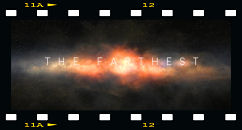 Originally proposed in the late 1960s to take advantage of a rare planetary alignment in the 1970s, NASA’s Voyager missions are slated for launch in 1977, loaded with the best technology available in 1972. The Farthest chronicles the design and construction, the launch, the discoveries and the in-flight triumphs and travails of the twin Voyager spacecraft, as told by the scientists and engineers who sent them on their journey and waited eagerly for the data from planets that, in some cases, had never been seen as more than a pinprick of light in a telescope. The Voyagers continue onward into interstellar space, having completed their planetary explorations, each carrying gold-plated “Golden Records”, audiovisual time capsules of life on Earth in 1977 that may outlive the entire human race.
Originally proposed in the late 1960s to take advantage of a rare planetary alignment in the 1970s, NASA’s Voyager missions are slated for launch in 1977, loaded with the best technology available in 1972. The Farthest chronicles the design and construction, the launch, the discoveries and the in-flight triumphs and travails of the twin Voyager spacecraft, as told by the scientists and engineers who sent them on their journey and waited eagerly for the data from planets that, in some cases, had never been seen as more than a pinprick of light in a telescope. The Voyagers continue onward into interstellar space, having completed their planetary explorations, each carrying gold-plated “Golden Records”, audiovisual time capsules of life on Earth in 1977 that may outlive the entire human race.
written by Emer Reynolds
directed by Emer Reynolds
music by Ray Harman
Appearing as themselves: Fran Bagenal (Co-Investigator, Plasma Science), Jim Bell (Author, “The Interstellar Age”), John Casani (Voyager Project Manager), Timothy Ferris (Golden Record Producer), Suzanne Dodd (Current Voyager Project Manager), Don Gurnett (Principal Investigator, Plasma Wave Science), Heidi Hammel (Planetary Science), Candy Hansen-Koharcheck (Imaging Science Representative), Andrew Ingersoll (Atmospheric Science), Charley Kohlhase (Mission Design & Navigation), Lawrence Krauss (Theoretical Physicist & Cosmologist), Stamatios “Tom” Krimigis (Principal Investigator, Particle Science), Dave Linick (Sequence Team Chief), Frank Locatell (Project Engineer, Mechanical Systems), Jon Lomberg (Golden Record Design Director), Linda Morabito (Navigation Engineer), Carolyn Porco (Imaging Scientist), Nick Sagan (Author & Screenwriter), Brad Smith (Imaging Science Team Leader), Larry Soderblom (Imaging Science), Ed Stone (Voyager Chief Scientist), Linda Spilker (Infrared Science Representative), Janet Sternberg (Golden Record Greeting), Rich Terrile (Imaging Science)
LogBook entry and review by Earl Green
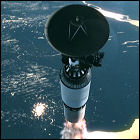 Review: I vividly remember, as a kid still in my single digits, obsessively reading and re-reading the National Geographic cover articles that accompanied every Voyager planetary flyby. I was already interested in space and planets, thanks to a Star Wars tie-in book that pivoted my attention from made-up planets to real ones; now I could be engrossed. At that age, I didn’t necessarily understand the chemistry, the particle physics, the atmospheric fluid dynamics, or the electromagnetic forces involved, but that was okay; Rick Gore, the National Geographic writer who almost inevitably got the Voyager assignments, was a master at explaining things, and until understanding dawned, like the rest of the public, I had those pictures to be mesmerized by. Oh, and tales of scientists and engineers like Brad Smith, Carolyn Porco, Rich Terrile, Linda Morabito, Larry Soderblom, and Charley Kohlhase at the wheel, driving each Voyager to its next destination almost as if by gravitational trigonometry magic. Kids my age were supposed to be idolizing movie stars and rock stars; these people were my rock stars, equally adept at revealing chunks of orbiting rock or their huge, gaseous parents that surely just missed becoming their own stars. Now, 40 years on, you put a movie in front of me that lets all of these same people tell the story of Voyager in their own words? That’s probably my favorite movie of that year.
Review: I vividly remember, as a kid still in my single digits, obsessively reading and re-reading the National Geographic cover articles that accompanied every Voyager planetary flyby. I was already interested in space and planets, thanks to a Star Wars tie-in book that pivoted my attention from made-up planets to real ones; now I could be engrossed. At that age, I didn’t necessarily understand the chemistry, the particle physics, the atmospheric fluid dynamics, or the electromagnetic forces involved, but that was okay; Rick Gore, the National Geographic writer who almost inevitably got the Voyager assignments, was a master at explaining things, and until understanding dawned, like the rest of the public, I had those pictures to be mesmerized by. Oh, and tales of scientists and engineers like Brad Smith, Carolyn Porco, Rich Terrile, Linda Morabito, Larry Soderblom, and Charley Kohlhase at the wheel, driving each Voyager to its next destination almost as if by gravitational trigonometry magic. Kids my age were supposed to be idolizing movie stars and rock stars; these people were my rock stars, equally adept at revealing chunks of orbiting rock or their huge, gaseous parents that surely just missed becoming their own stars. Now, 40 years on, you put a movie in front of me that lets all of these same people tell the story of Voyager in their own words? That’s probably my favorite movie of that year.
The Farthest is far from the only documentary to have been made on the subject of the Voyager mission, but it’s the best of the bunch by quite a stretch. Avoiding the glaring factual errors of prior documentaries (I remember one BBC-produced piece in particular that, while nicely executed, seemed to revolve around the idea that Carl Sagan was in charge of the Voyager program), The Farthest focuses on the human beings who conceived, designed, built, and operated the vehicles, and the human scientists who patiently 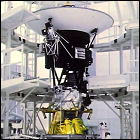 awaited the data return from worlds seldom, if ever, previously visited. The almost-human foibles of their robotic creations are also laid bare: each Voyager ran into problems during or immediately after launch that could’ve ended their missions without leaving Earth orbit. The 1977 footage of the Voyagers’ construction and encapsulation (mounting in an aerodynamic rocket nose cone prior to launch) has been seen before, but it hasn’t been narrated by engineer Frank Locatell before, whose fondness and reverence for the accomplishments of the vehicles he helped to build is palpable. When he talks about the engineers’ work being done and the vehicles now being the property of scientists and flight controllers, he says it with moistened eyes: he’d helped to birth a mechanical creature that was never to return, and you’d swear he was talking about his own kids. I kind of wanted to hug him and tell him it was okay.
awaited the data return from worlds seldom, if ever, previously visited. The almost-human foibles of their robotic creations are also laid bare: each Voyager ran into problems during or immediately after launch that could’ve ended their missions without leaving Earth orbit. The 1977 footage of the Voyagers’ construction and encapsulation (mounting in an aerodynamic rocket nose cone prior to launch) has been seen before, but it hasn’t been narrated by engineer Frank Locatell before, whose fondness and reverence for the accomplishments of the vehicles he helped to build is palpable. When he talks about the engineers’ work being done and the vehicles now being the property of scientists and flight controllers, he says it with moistened eyes: he’d helped to birth a mechanical creature that was never to return, and you’d swear he was talking about his own kids. I kind of wanted to hug him and tell him it was okay.
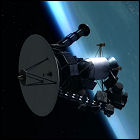 While Locatell correctly points out that, once bolted into their rocket fairings, the Voyagers would never again be seen by human eyes, extensive CGI work brings them to life in settings both realistic and just plain photogenic. The recreated launch sequences are stunning, showing how each Voyager was stowed, deployed, and sent on its way; paired with the canny, period-appropriate and utterly happy-go-lucky chorus of Gallgher & Lyle’s “Breakaway”, this scene of the movie just made me burst out into a giant grin. Look at ’em go! Maybe Frank’s well within his rights to get all misty-eyed.
While Locatell correctly points out that, once bolted into their rocket fairings, the Voyagers would never again be seen by human eyes, extensive CGI work brings them to life in settings both realistic and just plain photogenic. The recreated launch sequences are stunning, showing how each Voyager was stowed, deployed, and sent on its way; paired with the canny, period-appropriate and utterly happy-go-lucky chorus of Gallgher & Lyle’s “Breakaway”, this scene of the movie just made me burst out into a giant grin. Look at ’em go! Maybe Frank’s well within his rights to get all misty-eyed.
From there, the movie shifts, sometimes a bit jarringly, back and forth between tales of the planetary encounters themselves, and tales of the development of the near-fabled Golden Record affixed to each Voyager. At one point in the movie, one of the people involved with the Golden Record remarks, “The scientists have got to be sick of everyone wanting to hear about the damned record,” and…that’s a valid point. Realistically, we’re probably within 15 years of each of the Voyagers’ nuclear power sources fading to the point that data return to Earth is no longer 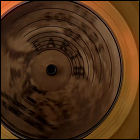 possible, and the movie points out that, at that moment, the Golden Record becomes the last remaining purpose of the mission – even if no alien life ever finds it, it’s a message in a bottle that, by escaping the heliosphere, will likely survive the final death of our sun in five billion years. If, in that time, humanity has either failed to set up shop elsewhere or has extinguished itself over petty tribal squabbles or irreparably damaging its home planet’s ecosphere (possibilities that seem uncomfortably plausible in 2017), a couple of metallic 12″ LPs are all that remain of us. (Take that, MP3s.) And while that’s simultaneously humbling and sobering, the Golden Records are not the entire story of Voyager, though the disproportionate amount of attention they receive in nearly every documentary about the Voyager program might lead you to believe otherwise. Don’t get me wrong, it’s a fun story – whether it’s about the sourcing of the material, to a six-year-old Nick Sagan ad-libbing the line “hello from the children of Planet Earth”, to the protests over the line drawings of naked human beings on the Pioneer plaques – but it eats up a lot of time that could’ve been lavished on the actual science of the Voyager flybys.
possible, and the movie points out that, at that moment, the Golden Record becomes the last remaining purpose of the mission – even if no alien life ever finds it, it’s a message in a bottle that, by escaping the heliosphere, will likely survive the final death of our sun in five billion years. If, in that time, humanity has either failed to set up shop elsewhere or has extinguished itself over petty tribal squabbles or irreparably damaging its home planet’s ecosphere (possibilities that seem uncomfortably plausible in 2017), a couple of metallic 12″ LPs are all that remain of us. (Take that, MP3s.) And while that’s simultaneously humbling and sobering, the Golden Records are not the entire story of Voyager, though the disproportionate amount of attention they receive in nearly every documentary about the Voyager program might lead you to believe otherwise. Don’t get me wrong, it’s a fun story – whether it’s about the sourcing of the material, to a six-year-old Nick Sagan ad-libbing the line “hello from the children of Planet Earth”, to the protests over the line drawings of naked human beings on the Pioneer plaques – but it eats up a lot of time that could’ve been lavished on the actual science of the Voyager flybys.
The vintage video footage of press conferences and the behind-the-scenes workings at JPL are amazing to behold. It’s easy to take for granted, in a day and age when you can pull up live YouTube coverage of a SpaceX launch and landing or Juno arriving at Jupiter or the latest landing of a Mars rover, that watching the incredibly interplanetary panoramas appear on the screens at JPL was a privilege reserved for the few who were actually there. I remember staying up 36+ hours over a weekend in August to watch PBS air live reports from JPL as Voyager 2 closed in on, 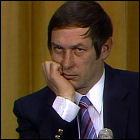 and ultimately flew directly over, Neptune. It just wasn’t like that for prior flybys: press conferences and pictures were handed out by NASA in the hopes that the amazing discovery of active volcanoes on a moon of Jupiter might make the “B” section of the next day’s newspaper, or maybe the “B” block of a national newscast. The scientists attached to the Voyager project often had to assemble “instant science” briefings, with little more than the data just beamed back from deep space, trying to sound authoritative about what were frequently the best possible educated guesses about what the Voyagers were seeing. This footage is sometimes unintentionally funny – Larry Soderblom’s long-suffering mute glare toward a reporter asking him to “repeat that, but with more details” may not have been, in the strictest sense, polite…but it is laugh-out-loud funny as hell. Even the esteemed Carl Sagan, usually mentioned due to his formative role in the Golden Record, is shown slumped on the floor, short on sleep and overwhelmed with new data and pictures coming in. This is a movie about people, not just machines and data.
and ultimately flew directly over, Neptune. It just wasn’t like that for prior flybys: press conferences and pictures were handed out by NASA in the hopes that the amazing discovery of active volcanoes on a moon of Jupiter might make the “B” section of the next day’s newspaper, or maybe the “B” block of a national newscast. The scientists attached to the Voyager project often had to assemble “instant science” briefings, with little more than the data just beamed back from deep space, trying to sound authoritative about what were frequently the best possible educated guesses about what the Voyagers were seeing. This footage is sometimes unintentionally funny – Larry Soderblom’s long-suffering mute glare toward a reporter asking him to “repeat that, but with more details” may not have been, in the strictest sense, polite…but it is laugh-out-loud funny as hell. Even the esteemed Carl Sagan, usually mentioned due to his formative role in the Golden Record, is shown slumped on the floor, short on sleep and overwhelmed with new data and pictures coming in. This is a movie about people, not just machines and data.
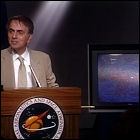 As much as I might rail against the Golden Record story sucking the air out of the room – not a word is mentioned about Voyager 1’s first photo, looking back at the Earth and the moon, which would’ve made a great contrast to its final photo of Earth as Sagan’s “pale blue dot suspended in a sunbeam” in 1990 – The Farthest is a fantastic entry point for those who want to dive deeper into either side of the story. There are lots of resources for that sort of information (full disclosure: I’ve given it a go myself). If The Farthest causes some youngster’s eyes to open wide and look up at the stars and planets and moons like “The Star Wars Question & Answer Book About Space” once did for me, it has more than earned its keep.
As much as I might rail against the Golden Record story sucking the air out of the room – not a word is mentioned about Voyager 1’s first photo, looking back at the Earth and the moon, which would’ve made a great contrast to its final photo of Earth as Sagan’s “pale blue dot suspended in a sunbeam” in 1990 – The Farthest is a fantastic entry point for those who want to dive deeper into either side of the story. There are lots of resources for that sort of information (full disclosure: I’ve given it a go myself). If The Farthest causes some youngster’s eyes to open wide and look up at the stars and planets and moons like “The Star Wars Question & Answer Book About Space” once did for me, it has more than earned its keep.


